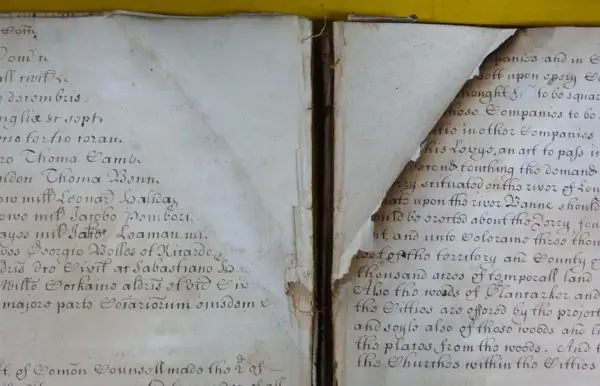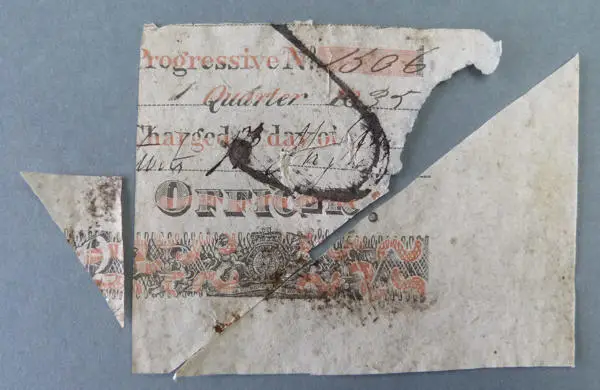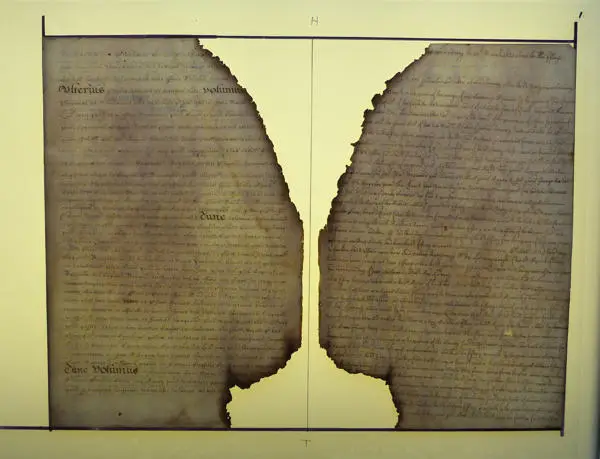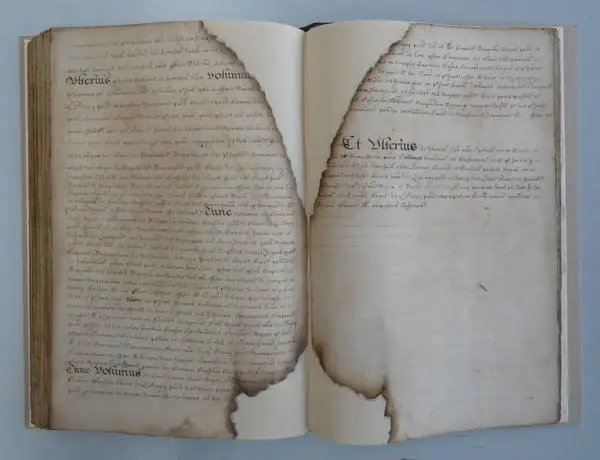Conservation in action: repairing a fire-damaged Irish Society memorandum book
The memorandum book of The Honourable the Irish Society (CLA/049/EM/04/002) contains copies and extracts of significant seventeenth century documents regarding the Society and the plantation in Ulster; including copy letters, reports, inquisitions, and extracts of records regarding the plantation; and copy leases and conveyances of land and property in Ulster. It is one of several items which were burnt in the Guildhall fire of 1786. As the original leases recorded in the book did not survive, it is in high demand among researchers and frequently comes up for consideration as part of LMA’s Access to Unfits programme. Conservator Tim Warrender describes his work to make its contents accessible once again, including reversing old repairs that were obscuring text, and an unexpected find within its pages.
Background
Whilst there is not a specific mention of this book, Irish Society minutes show that they wanted to get several items back into a useable state fairly soon after the fire. The style of the repairs and rebinding of the book are not inconsistent with being mid-nineteenth century. The loss due to the fire damage is greater at the top of the page than the base, and there has been trimming to all edges, including the spine. This has led to all of the pages now being single sheets. There are watermarks on the sheets (Strasburg Lily). Each side is numbered in ink up to 222, with the last four sides unnumbered. Due to the trimming, some of these numbers are now off the edge of the page, so the book must have been numbered before it was repaired.

The repairs are a white machine made paper which has been glued to the rear of the sheet, overlapping the edge by as much as 50mm, and obscuring text. On alternate sheets, there is an infill of rough light brown paper. This infill has a straight cut edge and does not follow the line of the missing area. On some pages, the repair had stuck to the opposing page too, leading to either the page or the repair being torn. All of the pages showed a lot of brown staining in the centre. The binding is full red leather, but now has lost strength, especially on the spine, where the book is now divided into several clumps. The pages have been oversewn over recessed cords.
Conservation treatment
As the binding was not original, and had no strength left, it was decided that there was no merit in trying to keep the book as it was. The existing paper repairs severely hampered the reading of the book, so these had to be removed.
What remained of the spine was removed, first by scraping down the leather and glue, and then by softening the remaining glue by placing a damp blotter on top.
As the pages were stained, a localised removal of the old repairs may well have led to tide marks appearing in the sheets. Therefore, it was decided that the whole sheet should be wet, and this would be done on the suction table. First the whole sheet was wetted under a very low suction. After a short while the glue on the old repairs was soft enough for removal. When these repairs had been removed, the sheet was wetted again, with particular attention being given to the brown stained areas (to wash out some of the stain) and the edges of the sheet, where any staining elements could rest. The suction was then turned up higher to dry out the sheet, again with care to make sure that tide marks didn’t appear – if it was looking as though they were forming, the sheet was wetted again.

On removing some of the repairs, it was found that there was some re-used paper, and a couple of these pieces made up a kind of receipt, which was dated 1835, so the repairs must be after that date. After some research, it was found that the receipt was actually a paper excise duty receipt, and there was also an excise stamp on other pieces of repair. Therefore, the rough paper was a wrapper for a ream of paper. This had probably not been kept for long and may have been reused within five years of the date.
By looking at the watermarks in the paper, the original make-up of the sections could be ascertained (seeing which watermarks were upside down etc), and it also appeared that there were some half-sheets missing, whereas only one pair of numbers (81-82) was missing. By aligning the chain marks in the paper, the ‘missing’ gap where the spine had been trimmed could be assessed. Once this gap was established, I made a template for the size of the folios. This is not for the original size of the sheet as it was impossible to guess how much had been trimmed from the outside. The template was made with a permanent pen on a polyester sheet. To take into account the slight differences in sheet size needed between the outer and inner sheets in each section, the outer sheets were lined up to the outside of the black line, gradually moving to the inner sheets to the inside of the line.

For the repairs, first a Japanese paper was selected. As the original sheets were fairly thick, and no suitable Japanese paper of a similar thickness was available, I decided upon two layers of a thinner paper, the first of which was slightly larger to give a minimal overlap onto the original sheets. After the first infill was applied, the sheet was turned over and the second infill was added. This was followed by a small strip of Japanese tissue called Tosa Tengujo for added strength on the joint – this would be on the outside of the finished sheet. For the sheets where one half was missing, a smaller guard was added to denote that something was missing. Pages at the very start and end of the book were also missing – these were made up with new full pages so that these could be used as new endpapers.
Now that the sections had been made back up to the original size, the boards used in the nineteenth century re-binding were too small, and so could not be used for the new binding.

This book, and the information it contains, are now more accessible than any time since the fire of 1786, although the corners which have been burnt are lost forever.
Further reading
For the project to conserve and digitally reconstruct the Great Parchment Book, a parchment volume belonging to the Irish Society damaged in the same fire, see the dedicated website.